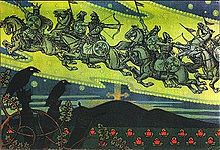This article needs additional citations for verification. (July 2012) |


In Hungarian mythology, Prince Csaba was the youngest son of Attila, King of the Huns. A fierce and skilled warrior, he led the Huns to victory in all the battles they encountered over the ages. He is the legendary leader of the Székelys.
But after Csaba's death, the Huns had no one to take his place. Seizing their chance, the enemies of the Huns launched an assault on the Hun kingdom. As they met on the field of battle, the enemy generals mocked the Huns, saying "and who will save you now that Csaba is gone?" But no sooner had those words been spoken, a bright pathway consisting of stars appeared in the night sky and Csaba rode down at the head of an army from the heavens. Csaba and his army routed the Frankish invaders and saved the Huns once again,[1] and three more times he returned down the "Skyway of the Warriors" to defend his people. According to some versions of the legend, he was seen once more several centuries later leading Árpád and the Hungarians, a brother tribe of the Huns, over the Carpathians and into the land that is today known as Hungary.[citation needed]
Consequently, the meaning of the Hungarian name Csaba (Csaba - "A gift from the sky" or "A gift from the heavens") is said to have been derived from this legend.
Simon of Kéza and Mark of Kalt claimed that he was the legendary ancestor of the Aba clan;[2][3][4] Mark additionally claimed that he was the legendary ancestor of the Árpád dynasty.[5][a]
György Györffy argued the character of Prince Csaba was compiled from real people, such as the 10th-century chieftain Csaba and the 11th-century comes Csaba (or Aba), a confidant of the first king Stephen I of Hungary. The former indeed left Hungary for the Balkans together with his tribe in the mid-10th century, while the latter was perhaps the father of Samuel Aba and thus ancestor of the prestigious Aba clan.
- ^ Bishop Gregory, commenting on a raid into Frankish territory in 566
- ^ of Kéza, Simon (1999). Veszprémy, László; Schaer, Frank (eds.). The Deeds of the Hungarians. Central European University Press. p. 73. ISBN 963-9116-31-9.
Csaba was Attila's legitimate son by the daughter of the Greek emperor Honorius. Csaba in turn had two sons, Edemen and Ed. Edemen entered Pannonia with his father's and mother's great entourage (his mother being a Chorasminian) when the Hungarians came back for the second time, whereas Ed remained in Scythia with his father. Csaba is the ancestor of the clan of Aba.
- ^ Simon of Kéza, Gesta Hunnorum et Hungarorum. Károly Szabó's Hungarian translation, quote: "Tehát ez a Csaba Ethelének Honorius görög császár leányától született törvényes fia, kinek fiait Edeménnek és Ednek hívták. Edemén osztán, mikor a magyarok másodszor visszatértek Pannoniába, atyja és anyja igen nagy atyafiaságával bejöve, anyja ugyanis a korozmin nemzetből való vala; Ed pedig Scythiában marada atyjánál. Ezen Csabától származott az Aba nemzetsége."
- ^ Mark of Kalt, Chronicon Pictum. László Geréb's Hungarian translation, quote: "Csaba Attila törvényes fia volt, Honorius görög császár leányától; az ő fiait Edöménnek és Ednek hívták. Mikor a magyarok másodízben tértek vissza Pannóniába, Edömén atyjának és anyjának nagyszámú atyafiságával jött el, mert anyja khvarezmi származású volt. Ed pedig Szittyaországban maradt atyjánál. Csabától ered az Aba nemzetség."
- ^ Mark of Kalt, Chronicon Pictum. László Geréb's Hungarian translation, quote: "Ama kapitányok közt a leggazdagabb és hatalmasabb Árpád volt, Álmos fia, aki Előd fia, ez meg Ögyek fia. [...] Miután a somnium a mi nyelvünkön álom, s ama fiú származását álom jövendölte meg, ezért nevezték Álmosnak, aki Előd, ez Ögyek, ez Ed, ez Csaba, ez Etele, ez Bendegúz, [...]"
- ^ Anonymus (author), Martyn Rady (translator) (2009) Gesta Hungarorum. pdf, p. 7-12
- ^ Anonymus (author), Martyn Rady (translator) (2009) Gesta Hungarorum. pdf, p. 12-16, 23, 33-34.
Cite error: There are <ref group=lower-alpha> tags or {{efn}} templates on this page, but the references will not show without a {{reflist|group=lower-alpha}} template or {{notelist}} template (see the help page).